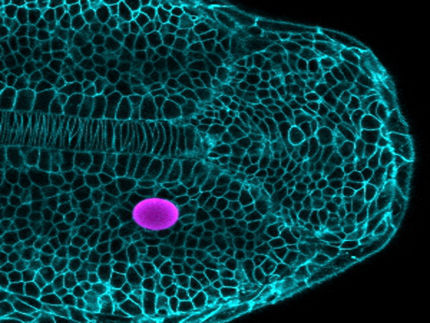How do embryos measure time?
Study sheds light on genetic “clock” in embryonic cells
As they develop, vertebrate embryos form vertebrae in a sequential, time-controlled way. Scientists have determined previously that this process of body segmentation is controlled by a kind of “clock,” regulated by the oscillating activity of certain genes within embryonic cells. But questions remain about how precisely this timing system works.
A new international cross-disciplinary collaboration between physicists and molecular genetics researchers advances scientists’ understanding of this crucial biological timing system. The study, co-authored by McGill University Prof. Paul François and Ohio State University Prof. Sharon L. Amacher and published in Developmental Cell, sheds light on the clock mechanism by providing the first real-time, visual evidence of how it operates at the level of individual cells.
While previous scientific studies have examined the oscillation phenomenon in the tissue of mouse embryos, the McGill and Ohio State researchers were able to observe and analyze it in single cells. To do so, they genetically modified zebrafish. The researchers used a fluorescent marker in the transgenic fish and developed software tools to monitor the concentration of a certain “cyclic” protein, whose production rises and falls with the oscillating expression of the molecular clock genes.
It is known that cells communicate with neighboring cells through a messaging system known as the Notch signaling pathway. In their experiments with the zebrafish, the researchers cut off this inter-cellular communication network – enabling them to see how that would affect the oscillation pattern in individual cells and their neighbors.
These experiments revealed that cyclic protein concentrations in individual cells of the zebrafish continued to rise and fall, indicating that they continued to oscillate. With the inter-cellular signaling pathway blocked, however, the oscillations were no longer synchronized among neighboring cells. The cellular clocks were still ticking, in other words, but not in unison. This finding confirms that the Notch pathway serves to coordinate timing among cells – a crucial role, since the cells must act in concert in order to form vertebrae.
By observing normal zebrafish embryos, the researchers were also able to show that cells desynchronize their oscillations while performing cellular division, then later resynchronize with their neighbors as they proceed collectively to form vertebrae.
“In humans, defects in Notch signaling are associated with congenital developmental disorders called spondylocostal dysostosis, that are typified by scoliosis and trunk dwarfism caused by malformed ribs and vertebrae,” Amacher notes. “Studies such as ours may provide insight into potential therapies for human disease. It is likely that many cells in our bodies - stem cells, cancer cells - have similar molecular oscillators that regulate response to environmental signals. By unraveling such molecular clocks, we can understand how to modify them and thus change the number of oscillating cells that respond to differentiating signals, providing tremendous insight for studies in stem cell and cancer biology and tissue engineering."
“The formation of the vertebral column is very important, because everything follows from that” in the development of vertebrates, François adds. A physicist, he developed the computer tools used to analyze video footage of the zebrafish embryos. Francois’s research focuses on the modeling of physical properties of gene networks and their evolution – a field that has emerged at the nexus of biology and physics in recent years, following sequencing of the human genome and rapid growth in scientists’ understanding of the processes inside cells.
Most read news
Other news from the department science

Get the life science industry in your inbox
By submitting this form you agree that LUMITOS AG will send you the newsletter(s) selected above by email. Your data will not be passed on to third parties. Your data will be stored and processed in accordance with our data protection regulations. LUMITOS may contact you by email for the purpose of advertising or market and opinion surveys. You can revoke your consent at any time without giving reasons to LUMITOS AG, Ernst-Augustin-Str. 2, 12489 Berlin, Germany or by e-mail at revoke@lumitos.com with effect for the future. In addition, each email contains a link to unsubscribe from the corresponding newsletter.
More news from our other portals
Last viewed contents
Synovium
Agaricus_bitorquis
Category:Steroids
Nevoid_basal_cell_carcinoma_syndrome
EMBO_Journal
SGS Opens Up New Contract Analytical Laboratory for Quality Control Testing in Singapore
Study shows mirabegron effective and well tolerated for overactive bladder - New option for patients bothered by antimuscarinic side effects
Uranium
Richard_Schope
Sistrurus_ravus
24-Ethyl_coprostanol
























































